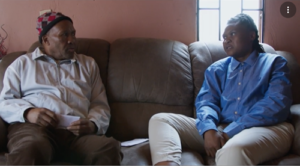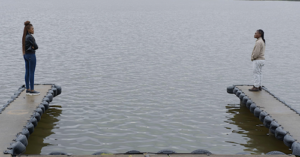By Robert St. Martin
Baldwin Hills, California (The Hollywood Times) 02/14/2024
Right now, the biggest event in Los Angeles for film lovers is the Pan African Film Festival which is held at the Cinemark Baldwin Hills Theatres at Crenshaw Plaza. Among the many films screened at this 10-day film festival is a salient documentary Who I Am Not (South Africa/Romania, 2023), in which documentarian Tüne Skovrán follows two intersex people in Johannesburg, South Africa as they deal with the difficulties of being intersex. Intersex people are people born with any of several sex characteristics including chromosome patterns, gonads, or genitals that do not fit binary notions of male or female bodies. Exact numbers are unknown, but it’s estimated there are globally a couple of million intersex people.
This exquisitely realized cinéma vérité documentary navigates the difficult instances of interphobia alongside rapturous, momentous moments of self-discovery on the part of the two stories we follow. Skovrán, who is from Romania, spent five years in South Africa working with the protagonists of the films and capturing their stories over that period of time.

Skovrán maintains her focus firmly on Sharon-Rose Khumalo and Dimakatso Sebidi throughout Who I Am Not, which results in a deeply personal, highly potent look at a community of people who generally have little exposure to the public. Sharon-Rose Khumalo identifies as a woman, but her XY chromosomes make her question this identity, as well as restricting her from having children. Dimakatso Sebidi, born with both male and female genitalia, similarly struggles to find their place in society, seeing themselves as neither gender. Simple tasks such as job interviews become impossible, such is the stigma and ignorance surrounding intersex. Sex and identity and their inextricable links are laid bare in Who I Am Not.
The focus of Who I Am Not is on Sharon-Rose Khumalo, a beauty queen with male genetics, and Dimakatso Sebidi, a male-presenting intersex activist. Their identities might differ, but they connect with similar feelings of alienation, mistreatment, and lack of belonging in society. As a viewer, we are respectfully invited into their lives by director Tünde Skovrán, whose patient, observational documentary style always ensures these two people are centered with compassion. Even in the most personal moments of Who I Am Not, the camera’s presence never feels intrusive.

Sharon-Rose was born with male chromosomes in a female body. She identifies as a woman but has no ovaries or uterus. She is ambitious and successful, and following her time as a beauty queen now works in medical marketing. She lives a middle-class life and has a glamorous selection of friends. However, like Dimakatso, she struggles with her identity and place in society.

Dimakatso’s medical story is less clear as their medical records have been destroyed by the hospital that operated on them as a child. Apparently born with both a penis and a vagina, they underwent several surgeries as a child to remove the penis and were brought up female. They feel that they should have been brought up as male. They identify as “they” and are in a loving relationship with a non-binary woman. They have breasts that they bind. Dimakatso is unemployed and their mental health regarding their intersexuality is not as strong as Sharon-Rose’s. They feel strongly that operations on intersex people should only be performed once the intersex person is old enough to decide for themselves as to what the operation should entail.

Contemporary South Africa is a country where religious belief is still common and profoundly impacts people’s view of sex, gender and acceptance. It’s telling that Dimakatso’s father asks God to forgive him, leaving a disenfranchised Dimakatso to ask about their agency in forgiveness. It is fascinating to watch how people come to terms with those born intersex: If God creates all, didn’t he also create the Intersex? If they are an aberration, then God is fallible. The religiosity extends to everyday interactions. A small business owner explains to Dimakatso that he can’t employ them because how would he refer to them? They answer, just with our name. This is clearly something he can’t wrap his head around and he rejects her job application while wishing her a “blessed day.”

Skovrán occasionally veers into more experimental territory, which has differing effects. Framing Sharon-Rose and Dimakatso through the visuals of the surrounding environment, such as rippling water or water droplets, is an interesting turn that inverts nature and challenges preconceived ideas of what is “normal.” Moments such as these reflect both of their long, difficult searches for identity, where their genetics or specific sex organs seem to narrowly define who they are. Other occasions, such as capturing a character in a swimming pool with ambient sound effects and ethereal lighting, feel more forced. At the Q&A after the screening, director Skovrán explained that she wanted water to be the metaphoric umbrella of the film’s imagery.

Who I Am Not is a fascinating film and worth of being seen by whole communities and at universities in promoting greater understanding and a larger conversation of intersex people. The film was part of the London Flare Film Festival, SXSW and Frameline in San Francisco.






